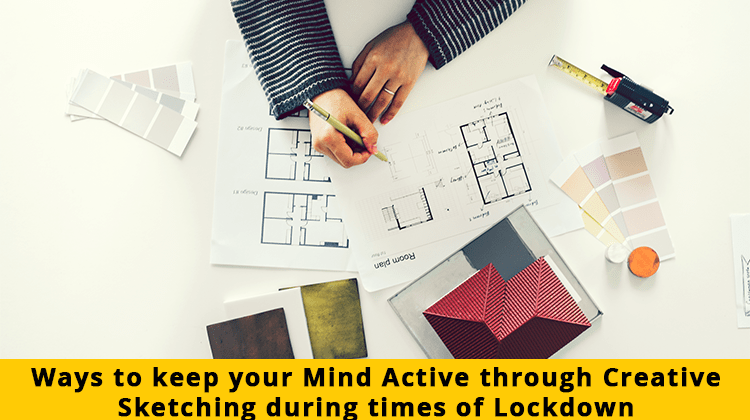The times are certainly tough, and probably one which will remain in our memories forever. Minding your mind during these times is imperative. With everyone looking at ways for escapism, and experiencing the feeling of dismal right now, look on the brighter side (a crucial side).
You need to look at this opportunity as a chance to refocus your attention to the important things in your life, things that you have been casting a shadow on. One productive thing a day during these tough times can have a surprisingly positive impact on your attitude. Use this opportunity to set your sights on long avoided tasks, reorganize or create something that you’ve always wanted to.
As artists or aspiring art and architecture students, this time is a wonderful opportunity to channel your inner artist. Use your brain, keep it flexible, well-functioning and young. There is nothing to lose and plenty to gain. Using a pencil and paper to draw or sketch pictures in time with drawing breath can enhance your connection between body and mind. As Terryl Whitlatch puts it: “Sketching is the equivalent of the daily ballet barre. It gets your imagination going and gives your skills a workout: it’s foundational for any artist. Sketching regularly helps you become better as an artist, and gives you a platform to experiment, mess up, try again (and again), and grow.” To become a skilled artist, you need to put in work every day and keep it up for years. Professionals eventually learn how to critique their own work and focus on their weaker areas to improve. Repetition is a big factor but mindset also plays a very important role.
Without any further ado, let us take a look at some technical pointers or techniques for getting inspired and bring out the sketch artist in you.
- Know your pencils and take control of it
Having the right pencil for your sketch is essential. As students you will be familiar with the fact that the hardness of graphite is indicated on the side of the pencil. Tim Von Rueden, travelling convention artist recommends starting somewhere on the H scale as a foundation and then finishing with the darker B scale. Positioning your hand closer to the end of the pencil will give you more control and precision but darker markings. For lighter markings grip the pencil further up.
- Try different marking methods
There are plenty of sketching techniques to help you achieve different styles and effects. While some prefer smoother value transitions with the pencil strokes blending in against a thin outline, some others may be more partial to cross-hatching against a bold outline.”
- Try varying your lines
By making subtle shifts in the width and darkness of your lines helps create a dynamic, and visually interesting drawing. Controlling the kind of mark, you put down can be tricky in the beginning, but with practice you will be able to create a variety of marks that work together to form a cohesive image.
- Avoid smudging and control your edges
While shading, using an extra piece underneath your hand could prove to be advantageous, helping you to reduce the amount your hand smudges your pencil lines. While it is frustrating trying to make a clean looking sketch that loses its finesse due to smudging, you sure can use smudging to your advantage to smoothen out shading.
Controlling edges- is a crucial part to bring a brilliant design to life. There are different techniques to define object edges and a particular technique needs to be used pertaining to the kind of sketch you want to create.
- Applying the 70/30 rule
What is the 70/30 rule and how it can help create effective sketches? You know how they say that “Less is more”? The idea is that 30 per cent of your sketch is filled with the main focus and detail, and the remaining 70 per cent is filler. This helps enhance the main subject of your artwork, sketching.
- Making it symmetrical, but not completely
Unique is what makes an artist as well as his art. Symmetrical drawing may look pretty, but with time they start to look boring. It’s exactly like how the flaws make a person unique and beautiful, and not just the perfection”.
An easy way to prevent this is to add some small changes and only keep the general lines symmetrical instead of mirroring every small part while Keeping some elements asymmetrical making it look less boring and more intriguing and attractive.
- Every texture is different. Differentiate and understand the difference.
To demonstrate different textures, you need to adjust your technique. A good starting point is to consider if the texture is rough or smooth, and then if it absorbs or reflects light. And continue on those lines.
At IID, we never use a “one size fits all” approach and train students in all the unique and innovative ways possible. Our aim is to bring out the creativity in you, and to do so we follow teaching methods that are like no other fostering your innovation and creative thinking.
Spontaneous drawing or sketching has been known to relive psychological stress, feel relaxed and help you concentrate more.
We understand these are difficult times, but you need to look at the positive side and keep pushing through. We’re here to support you and guide you through it all. So, get sketching and awaken that artist inside you. This really is an opportunity.












